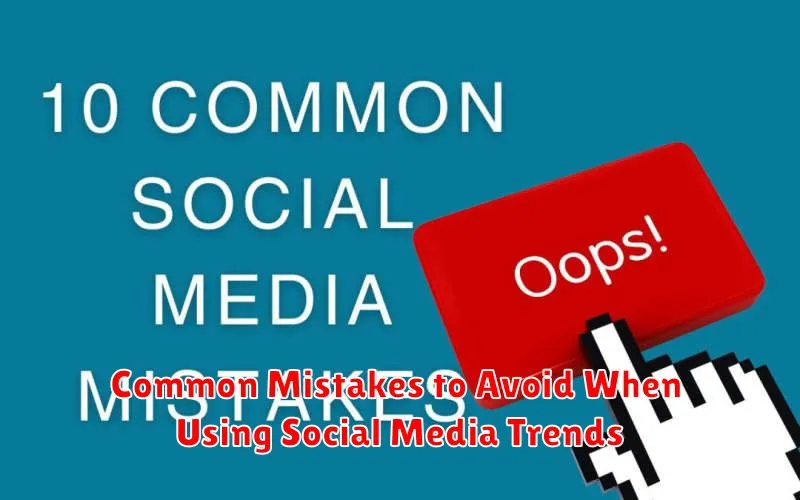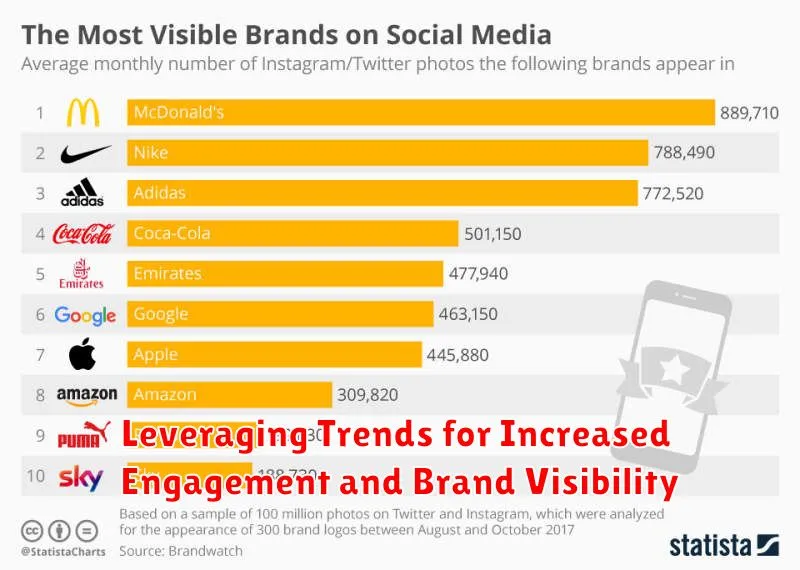In today’s rapidly evolving digital landscape, social media has become an indispensable tool for businesses seeking to expand their reach and cultivate a robust brand presence. Staying ahead of the curve requires more than just posting regularly; it necessitates a keen understanding of how to effectively leverage social media trends. This article will delve into the strategic utilization of trending topics, hashtags, and challenges to significantly boost your brand visibility, engagement, and ultimately, your bottom line. Mastering the art of riding the wave of social media trends can propel your brand to new heights, connecting you with a wider audience and solidifying your position within the competitive digital marketplace.
From ephemeral content like Instagram Stories and TikTok videos to viral challenges and trending hashtags, the opportunities presented by social media trends are vast and constantly evolving. This dynamic environment demands adaptability and a proactive approach. By understanding how to identify, analyze, and strategically integrate these trends into your social media strategy, you can significantly enhance your brand’s online presence. This article will provide actionable insights and practical guidance on how to harness the power of social media trends to boost your brand, fostering meaningful connections with your target audience and driving tangible results.
Understanding Social Media Trends
Social media trends are the dominant themes, topics, or formats that gain significant popularity and engagement within a specific timeframe. They can manifest as viral challenges, popular hashtags, trending audio clips, or even specific filters and effects. Understanding the nature of these trends is crucial for leveraging their power effectively.
Trends are often ephemeral, meaning they rise and fall in popularity quickly. Some are sparked by current events, while others emerge organically from within the platform’s user base. Recognizing the difference between a fleeting fad and a sustained trend is key to allocating your resources wisely.
Furthermore, different platforms breed different trends. What goes viral on TikTok might not resonate on LinkedIn. Platform-specific nuances in audience demographics, content formats, and overall culture influence the types of trends that emerge and thrive.
Identifying Relevant Trends for Your Brand
Not all trends are created equal, and jumping on every viral sensation can be detrimental to your brand image. Relevance is key. You need to identify trends that align with your target audience and your brand values. A trend might be popular, but if it doesn’t resonate with your specific niche, it won’t generate meaningful engagement.
Start by thoroughly researching your audience. What are their interests? What other brands do they follow? What kind of content do they engage with? Understanding your audience will provide valuable insights into which trends are likely to capture their attention.
Consider your brand identity. Does a particular trend align with your brand’s voice, message, and overall aesthetic? Participating in a trend that clashes with your brand identity can confuse your audience and damage your brand’s credibility. Focus on trends that complement your brand and reinforce your existing marketing efforts.
How to Incorporate Trends into Your Content
Once you’ve identified relevant trends, seamless integration is key to maximizing their impact. Don’t just slap a trending hashtag onto unrelated content. Instead, find creative ways to weave the trend into your brand’s narrative.
Relevance is paramount. Ask yourself if the trend aligns with your brand’s values and target audience. A forced fit will appear inauthentic and could damage your brand’s credibility.
Consider the platform. A trending audio clip might be perfect for TikTok or Instagram Reels, but not for a LinkedIn post. Tailor your content format to the specific platform and the nature of the trend.
Timing is also crucial. Jump on trends early for maximum visibility, but avoid trends that are already waning. Late adoption can make your brand seem out of touch.
Finally, remember to add your own unique spin. Simply replicating a popular trend won’t make you stand out. Find a way to personalize the trend and connect it to your brand’s unique offerings.
Measuring the Success of Your Trend-Based Campaigns
Analyzing the performance of your trend-based campaigns is crucial to understanding their impact and refining your future strategies. Key metrics provide valuable insights into what resonated with your audience and what fell flat.
Start by tracking engagement metrics. These include likes, comments, shares, and retweets. A high level of engagement suggests that your content successfully captured attention and sparked interest. Monitor your reach to see how many unique users encountered your trend-related content. Impressions, while related, reflect the total number of times your content was displayed, even to the same user multiple times.
Beyond basic engagement, delve into website traffic if applicable. Did the trend-driven campaign lead to increased visits to your website? Track conversions, such as sign-ups, purchases, or downloads, stemming from the campaign. These demonstrate a more tangible impact on your business objectives.
Finally, consider sentiment analysis. While more qualitative, assessing the overall tone of comments and mentions related to your campaign can offer valuable feedback. Are people responding positively, negatively, or neutrally to your brand’s participation in the trend?
Staying Ahead of the Curve: Tools and Resources for Trend Spotting
Staying informed about emerging trends is crucial for effective social media marketing. Proactive trend spotting allows you to capitalize on opportunities before your competitors. Fortunately, various tools and resources can assist in this process.
Social Listening Tools are essential for monitoring conversations and identifying trending topics. These platforms track keywords, hashtags, and brand mentions across various social media channels, providing valuable insights into what audiences are discussing.
Trend Tracking Platforms specifically focus on identifying and analyzing emerging trends. They often categorize trends by industry, providing a curated view of relevant developments. These platforms frequently offer data visualizations and predictive analytics to help anticipate future trends.
Utilizing Google Trends can provide a broad overview of search interest over time. Analyzing search volume for specific keywords can reveal emerging trends and help gauge public interest.
Staying active on social media platforms and engaging with industry influencers can also help you identify trends organically. Observing what’s being shared and discussed within your niche can offer valuable insights into upcoming trends.
Common Mistakes to Avoid When Using Social Media Trends

While leveraging trends can be beneficial, it’s crucial to avoid common pitfalls that can damage your brand. Jumping on every trend is a major mistake. Not all trends align with your brand identity and forcing a connection can appear inauthentic.
Ignoring your target audience is another blunder. A trend popular with a different demographic might not resonate with your followers. Analyze whether a trend aligns with their interests before incorporating it.
Trendjacking sensitive topics is never advisable. Using tragedies or controversial events for promotional purposes is highly insensitive and can severely damage your brand reputation.
Lack of originality can also be detrimental. Simply copying what others are doing won’t make your content stand out. Find creative ways to incorporate trends while maintaining your unique brand voice.
Finally, failing to measure results prevents you from understanding what works and what doesn’t. Track key metrics to gauge the effectiveness of your trend-based campaigns.
Leveraging Trends for Increased Engagement and Brand Visibility

Successfully incorporating trends into your social media strategy can significantly enhance your brand’s visibility and engagement. By aligning with relevant trends, you demonstrate an understanding of your target audience’s interests and position your brand as current and relatable.
Increased engagement translates to higher visibility within social media algorithms. When your content resonates with a trending topic, it’s more likely to be seen by a wider audience, both followers and non-followers alike. This broader reach can introduce your brand to potential customers and solidify your presence within your industry.
Pro Tip: Don’t just jump on every trend. Carefully select trends that align with your brand values and resonate with your target audience. Authenticity is key to successful trend leveraging.
Trend-driven content can also spark valuable conversations and foster a sense of community around your brand. By actively participating in relevant discussions and offering unique perspectives, you can cultivate deeper connections with your audience and establish your brand as a thought leader.

